Application of Mxene material in flexible energy storage and devices
QQ Academic Group: 1092348845
Detailed
As the demand for wearable electronic products continues to increase, flexible energy storage devices have developed rapidly. MXenes has ultra-high volumetric specific capacity, metal conductivity, superior hydrophilicity and rich surface chemical properties, and is considered a promising flexible electrode. Pure MXene, MXene carbon composite materials, MXene metal oxide composite materials and MXene polymer composite materials have applications in flexible electronic devices such as sensors, nano generators and electromagnetic interference shielding. In addition, the application of MXenes materials in flexible devices affects the performance of stress, strain, conductivity, capacitance, etc., to help researchers maintain the balance of mechanical and electrochemical properties when designing flexible devices.
01
Flexible super capacitor
Compared with traditional carbon-based material batteries, flexible supercapacitors (SCs) are expected to achieve higher energy density per unit volume. First of all, MXene material shows ultra-high volumetric energy density because of its high energy density and large Faraday pseudocapacitance (derived from rich surface chemistry). In addition, due to the metal conductivity, MXene can also act as a current collector. Then, a flexible electrode composed of current collectors and active materials is expected to be completely built on a flat mxene sheet to further increase the volume energy density of flexible SCs and provide power for wear-resistant electrons. For flexible MXene-based composite materials, composite materials mainly include mxene and carbon nanomaterials, mainly including reduced graphene oxide (rGO) and carbon nanotubes (CNT), to prepare flexible film electrodes. This strategy effectively prevents the re-stacking of MXene flakes and significantly improves flexibility. Polymer is another promising additive. It can be combined with mxenes to greatly improve the mechanical properties of materials, especially conductive polymers, which can optimize mechanical strength without sacrificing conductivity. In addition, metal oxides with high Faraday pseudocapacitance can also be used to bond with MXene to obtain higher electrochemical performance. These nanocomposite methods help to prepare flexible MXene-based SCs, which have excellent flexibility, high specific capacity and excellent mechanical properties to provide power for wearable electronic products.

Although the above-mentioned flexibility and mechanical strength are improved, the use of the substrate not only complicates the manufacturing process, but also reduces the stability of the structure due to the weak connection between the electrode material and the substrate.
02
Flexible battery
Nowadays, smart wearable electronic products equipped with more and more complex functions put forward requirements for energy storage devices with high energy density and minimum volume, which makes energy batteries more competitive than power supercapacitors. MXenes material has metal conductivity, volumetric specific capacity, open 2D topological structure, and rich surface chemistry is expected to solve some problems. In addition, MXenes can also be made into flexible non-adhesive film electrodes to meet flexibility while maintaining high volumetric specific capacity requirements. For example, Liu et al. fabricated a layered structure of MXene lithium flexible film electrode through repeated crimping processes. This flexible hybrid film has excellent peel coating stability and has a small overpotential (32 mV at 1.0 mA cm 2). By synthesizing Ti3CNTx MXene etching-ultrasonic pathway, and then filtering into a flexible film. This pure MXene membrane electrode exhibits excellent cycling performance.
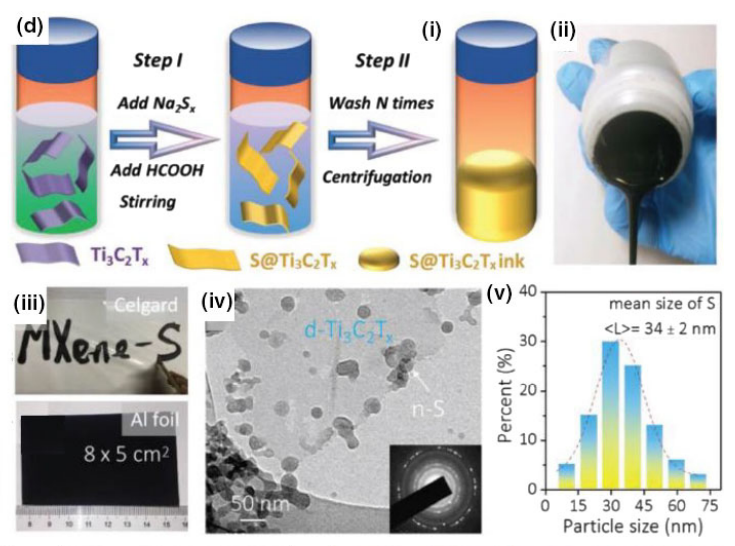
03
Flexible mxene-based material
Mxene/carbon-based composite
☑ Highly sensitive and large strain wearable sensor based on MXene/graphene composite film
The following figure shows the spontaneously formed Ti3C2Tx/graphene/PDMS layered structure, which can be divided into two layers after stretching: a brittle upper layer dominated by Ti3C2Tx and a flexible graphene/PDMS composite bottom layer. The coordinated movement of the upper and lower layers breaks and maintains the balance between the conductive paths, ensuring that the sensor has a high and stable gauge factor in a wide strain range (for example, the strain range is 0–52.6% and 52.6–74.1% when the strain The coefficients are 190.8 and 1148.2). The strain sensor based on Ti3C2Tx/graphene/PDMS layered structure also has a low detection limit (~0.025%), high linearity (R2>0.98), high cycle stability (more than 5000 cycles) and resistance to all-round human motion Accurate monitoring.
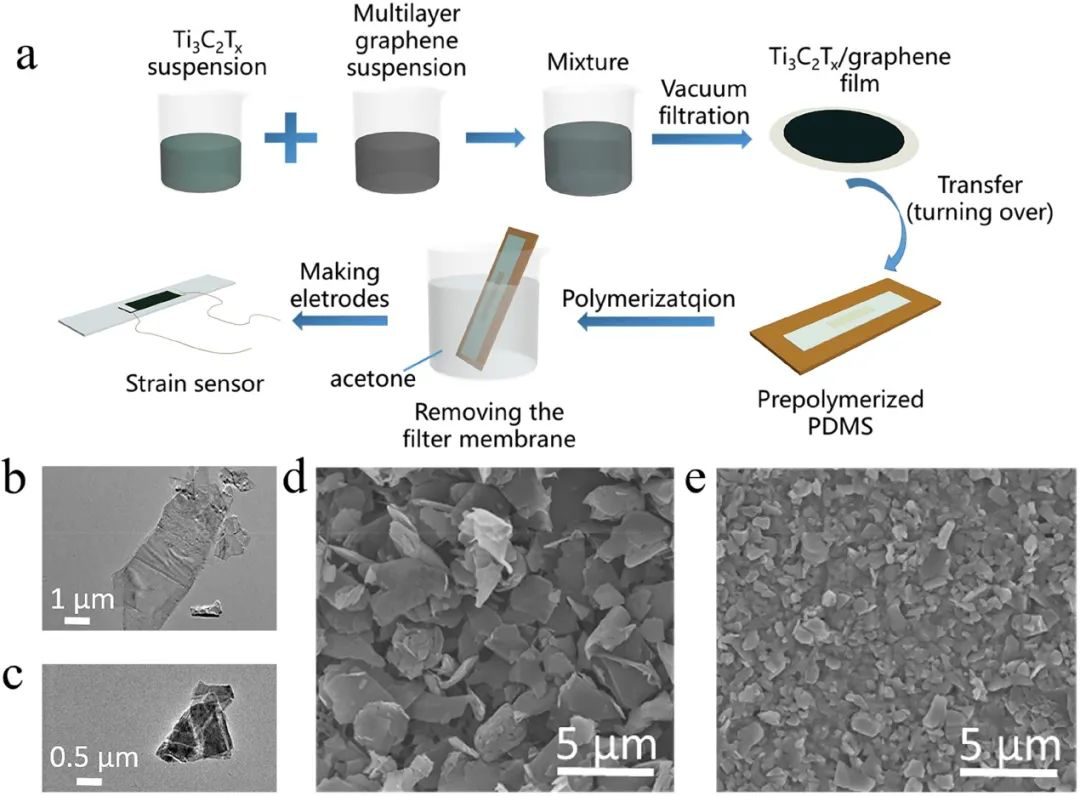
Source document "Ti3C2Tx MXene-graphene composite films for wearable strain sensors featured with high sensitivity and large range of linear response"
☑ MWCNTs are grown in situ on MXene particles and loaded on a CC substrate to prepare MXene@CC
The uniform electrodeposition of nickel-aluminum layered double hydroxide (Ni-Al-LDH) catalyst on MXene particles ensures the uniform growth of MWCNTs. Then, the catalytic MXene particles were subjected to low-pressure chemical vapor deposition (CVD) at 700°C under an argon flow. The grown MWCNT not only serves as a spacer to prevent the MXene film from re-clogging, but also as a charge collector within and between particles. In addition, the three-dimensional interconnect structure effectively improves the mechanical and physicochemical stability of the composite electrode.
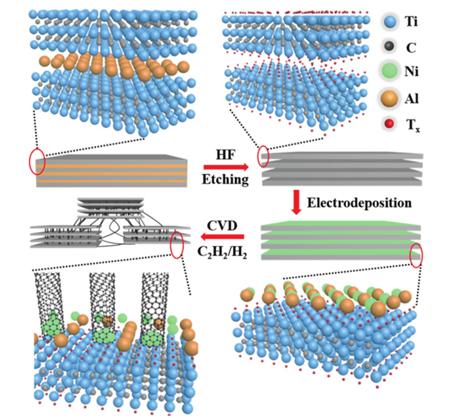
Source "In Situ Grown MWCNTs/MXenes Nanocomposites on Carbon Cloth for High-Performance Flexible Supercapacitors"
Mxene/MnO2 composite material
Compared with carbon nanomaterials, transition metal oxides such as MnO2 have ultra-high pseudo-capacitance, which is beneficial to significantly improve the low energy density of SCs. Therefore, it is best to combine transition metal oxides with MXene to further increase the volumetric capacitance. The hybrid membrane electrode used in SCs.
In a 2016 article, a simple and scalable hybrid filtration method was used to develop a MnO2/Ti3C2 hybrid material with a molecular stacking structure. Their respective advantages are combined in the composite material, thus providing excellent electrochemical performance. The highly flexible and symmetrical supercapacitor based on the new hybrid electrode has first-class electrochemical performance. The maximum energy and power density are respectively 8.3 W h kg-1 (221.33 W kg-1) and 2376 W kg-1 (at 3.3 W h kg). −1) It has good energy density and power density regardless of the bending state. This shows the huge possibility of application in future flexible and portable micro-power systems.
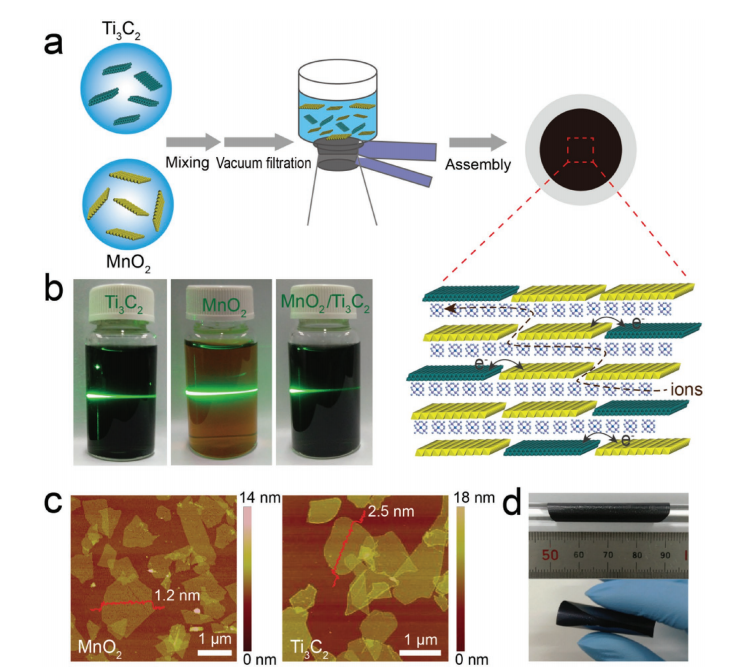
MXene polymer composite
The mechanical properties such as strength and flexibility of flexible SCs in wear-resistant electronic products are as important as electrochemical properties. The insertion of polymers between MXene layers will promote molecular-level coupling between MXene and polymer molecules. This close combination can effectively improve the strength and flexibility of the MXene polymer hybrid film, and effectively reduce the oxidation of MXene. Among various polymers, polyvinyl alcohol (PVA) has shown great potential in the preparation of MXene-based thin film electrodes due to its high solubility in water and abundant hydroxyl groups in the molecular chain. It can be used to form between polyvinyl alcohol and MXene. Hydrogen bond, with abundant negative oxygen and fluorine groups. For example, Lin et al. produced a flexible conductive material MXene@polyvinyl alcohol through a vacuum-assisted filtration film. While maintaining high electronic conductivity, it achieved a perfect match between mechanical and electrochemical properties. It is expected to meet the rigid requirements of flexible SCs to power consumer electronics.

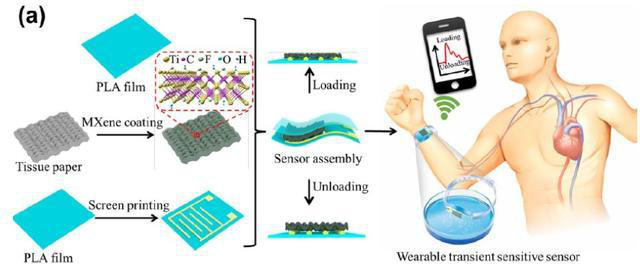
Representative flexible sensing applications of MXene/polymer nanocomposites
04
Mxene-based flexible device
In particular, the two-dimensional MXene combines many characteristics such as layered structure, rich surface chemistry, metal conductivity and hydrophilicity, which are of great significance to the sensor. Especially considering their essential biocompatibility, non-toxic and degradable properties for biosensors and gas sensors, MXenes have advantages over other widely studied 2D materials (graphene, MoS2, etc.).
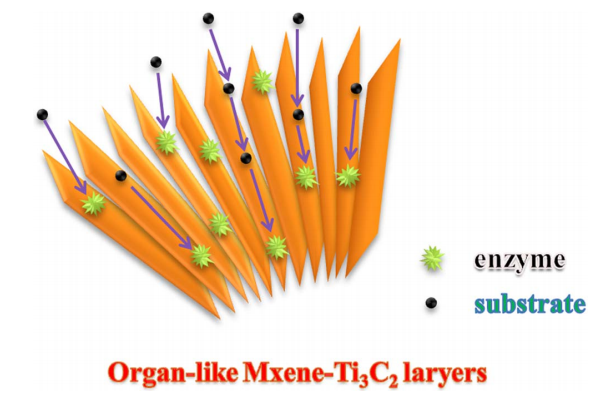
For example, Nafion / Hb / MXene-Ti3C2TX / GCE, a flexible biosensor without mediator, is used to detect NO2 and H2O2.
Source "An Organ-Like Titanium Carbide Material (MXene) with Multilayer Structure Encapsulating Hemoglobin for a Mediator-Free Biosensor".

The flexible Ti3C2TX/GO electrode manufactured by inkjet printing technology has excellent H2O2 detection performance. In addition, it was also found that MXenes can sense bromate (BrO3) and volatile organic compound (VOC) gases, such as NH3 and CH3COCH3.
Source "A flexible pressure sensor based on an MXene--textile network structure"
The Wan Pengbo team of Beijing University of Chemical Technology reported that a flexible wearable transient stress sensor with MXene grid can be used for highly sensitive, reproducible, wireless, degradable and wide range (up to 30 kPa) human-machine interface. The flexible stress sensor is assembled by dipping MXene into tissue paper and then sandwiching it between the biodegradable PLA sheet and the PLA sheet with interdigitated conductive electrodes. The assembled flexible stress sensor has high sensitivity, low detection limit (10.2 Pa), fast response (11 ms), low power consumption (10-8 W) and excellent reproducibility and reliability in 10,000 cycles Biocompatibility and harmless degradation. The stress sensor is connected to the human skin to obtain a wide range of biological monitoring data from small deformation to large motion.
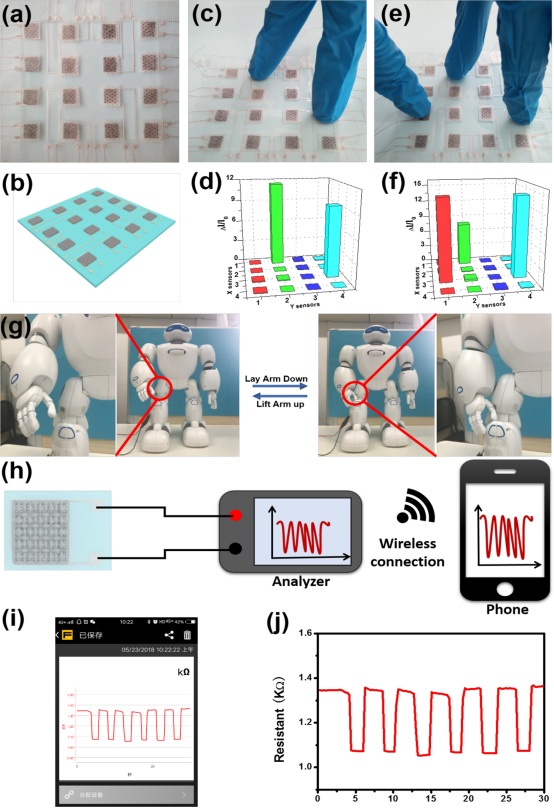
Source ""A Wearable Transient Pressure Sensor Made with MXene Nanosheets for Sensitive Broad-Range Human−Machine Interfacing"
Under the action of external force, the inter-layer spacing of MXene and the spacing between the MXene particles will be compressed accordingly. This mutual extrusion makes the conductivity of the sensitive layer composed of the MXene material change, so that its resistance value varies with It has changed. In order to further improve the deformation space of MXene under pressure, the researchers used the confinement effect of the micro-channel structure to make the distribution of MXene in the device form a three-dimensional stacked structure. The sensor can detect human pulse, throat movement, acceleration of objects and even sound signals, demonstrating the ultra-high sensitivity of the sensor. This single-structure design idea can effectively reduce the volume of the sensing element in the electronic device while realizing multi-functional detection, providing a new idea for future sensor development.
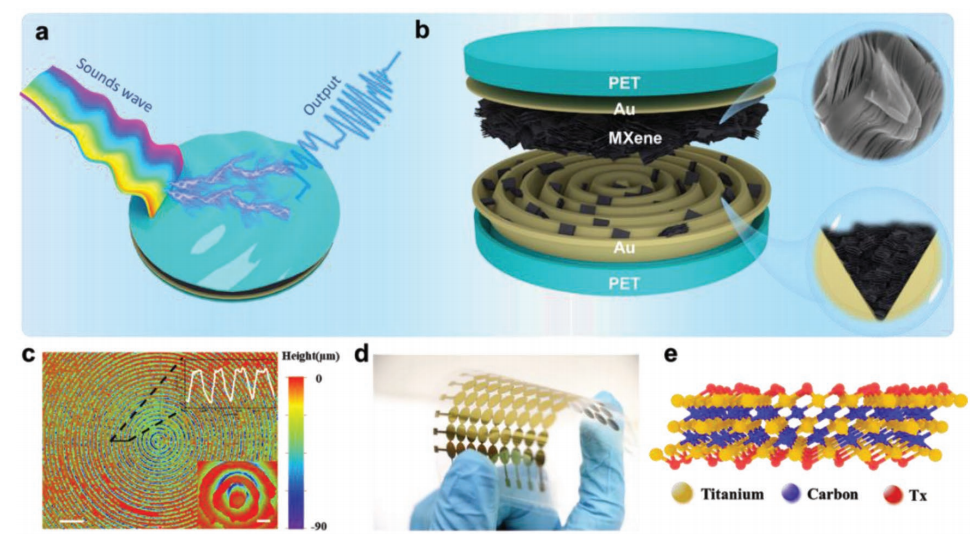
Source "Microchannel-Confined MXene Based Flexible Piezoresistive Multifunctional Micro-Force Sensor"
Swedish researchers have done research on the electrochemical performance of the representative M2CH2 (M = Ti or V) MXene as a cathode material for FIBs. Specifically:
1. First, determine the structural stability of M2CH2 with four different configurations by performing first-principles calculations.
2. Secondly, determine the most favorable adsorption site by analyzing the adsorption energy.
3. Then the electronic performance and charge compensation mechanism are systematically studied.
4. In addition, by calculating the migration energy barrier on the possible micro-diffusion path, the F-mobility of the M2CH2 monolayer surface can be predicted. In particular, the biaxial strain loading scheme (tension/compression) is used to comprehensively explore the F migration energy barrier under various strain states. The most important thing is to study the voltage distribution by gradually introducing F on the surface of the M2CH2 monolayer to simulate the F-embedding/de-embedding process and evaluate the corresponding specific energy.
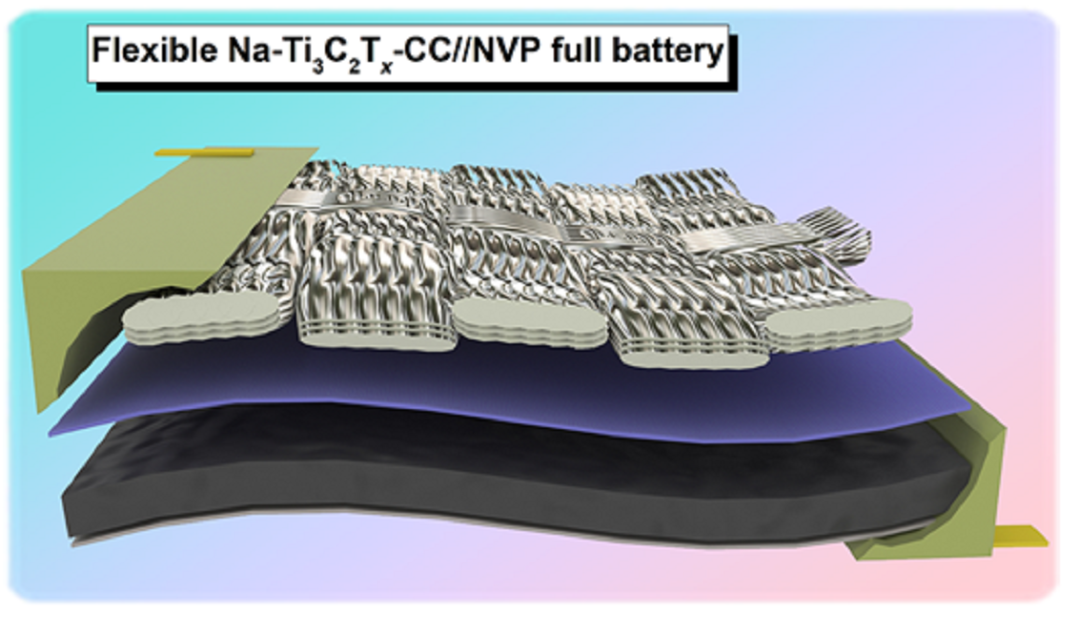
Source "Fluoride ion batteries: Designing flexible M2CH2 (M=Ti or V) MXenes as high-capacity cathode materials"
Na-Ti3C2Tx-CC exhibits excellent electrochemical stability and excellent machinability and bendability, so it is expected to be a candidate for flexible Na metal battery anodes. The team of Professor Cao Dianxue of Harbin Engineering University and the team of Professor Yingjin Wei of Jilin University simulated and assembled a flexible device and tested its electrochemical performance under bending.
05
to sum up
Flexible energy storage devices including supercapacitors and batteries represent a rapidly developing research direction and show great potential in the field of wearable consumer electronics. In the context of minimizing smart wearable electronic devices, MXenes has experienced rapid development of flexible supercapacitors due to insurmountable volumetric capacitance in recent years. Important issues facing two-dimensional nanomaterials have forced researchers to turn to freeze-drying or the introduction of sandwich structures. At the same time, compared with pure MXene with a low lateral dimension, the sandwich structure of polymers such as PVA and PPy can also enhance the mechanical properties of the MXene-based hybrid membrane. Due to the importance of mechanical strength and flexibility for flexible energy storage devices, carbon nanomaterials (including graphene and CNT) are also mainly used in combination with MXenes through a vacuum filtration method. Inspired by these hybridization strategies, the combination of transition metal oxide high pseudocapacitance and MXene can significantly increase the volume specific capacitance.
So far, although some achievements have been made in the application of MXene-based composite materials in flexible SC and batteries, there are still some challenges. One problem facing researchers is the non-negligible ion diffusion resistance along the vertical direction caused by layer-by-layer stacking, which greatly reduces the rate capability at high current densities. MX
Source "An Organ-Like Titanium Carbide Material (MXene) with Multilayer Structure Encapsulating Hemoglobin for a Mediator-Free Biosensor".
The flexible Ti3C2TX/GO electrode manufactured by inkjet printing technology has excellent H2O2 detection performance. In addition, it was also found that MXenes can sense bromate (BrO3) and volatile organic compound (VOC) gases, such as NH3 and CH3COCH3.
Source "A flexible pressure sensor based on an MXene--textile network structure"
The Wan Pengbo team of Beijing University of Chemical Technology reported that a flexible wearable transient stress sensor with MXene grid can be used for highly sensitive, reproducible, wireless, degradable and wide range (up to 30 kPa) human-machine interface. The flexible stress sensor is assembled by dipping MXene into tissue paper and then sandwiching it between the biodegradable PLA sheet and the PLA sheet with interdigitated conductive electrodes. The assembled flexible stress sensor has high sensitivity, low detection limit (10.2 Pa), fast response (11 ms), low power consumption (10-8 W) and excellent reproducibility and reliability in 10,000 cycles Biocompatibility and harmless degradation. The stress sensor is connected to the human skin to obtain a wide range of biological monitoring data from small deformation to large motion.
Source ""A Wearable Transient Pressure Sensor Made with MXene Nanosheets for Sensitive Broad-Range Human−Machine Interfacing"
Under the action of external force, the inter-layer spacing of MXene and the spacing between the MXene particles will be compressed accordingly. This mutual extrusion makes the conductivity of the sensitive layer composed of the MXene material change, so that its resistance value varies with It has changed. In order to further improve the deformation space of MXene under pressure, the researchers used the confinement effect of the micro-channel structure to make the distribution of MXene in the device form a three-dimensional stacked structure. The sensor can detect human pulse, throat movement, acceleration of objects and even sound signals, demonstrating the ultra-high sensitivity of the sensor. This single-structure design idea can effectively reduce the volume of the sensing element in the electronic device while realizing multi-functional detection, providing a new idea for future sensor development.
Source "Microchannel-Confined MXene Based Flexible Piezoresistive Multifunctional Micro-Force Sensor"
Swedish researchers have done research on the electrochemical performance of the representative M2CH2 (M = Ti or V) MXene as a cathode material for FIBs. Specifically:
1. First, determine the structural stability of M2CH2 with four different configurations by performing first-principles calculations.
2. Secondly, determine the most favorable adsorption site by analyzing the adsorption energy.
3. Then the electronic performance and charge compensation mechanism are systematically studied.
4. In addition, by calculating the migration energy barrier on the possible micro-diffusion path, the F-mobility of the M2CH2 monolayer surface can be predicted. In particular, the biaxial strain loading scheme (tension/compression) is used to comprehensively explore the F migration energy barrier under various strain states. The most important thing is to study the voltage distribution by gradually introducing F on the surface of the M2CH2 monolayer to simulate the F-embedding/de-embedding process and evaluate the corresponding specific energy.
Source "Fluoride ion batteries: Designing flexible M2CH2 (M=Ti or V) MXenes as high-capacity cathode materials"
Na-Ti3C2Tx-CC exhibits excellent electrochemical stability and excellent machinability and bendability, so it is expected to be a candidate for flexible Na metal battery anodes. The team of Professor Cao Dianxue of Harbin Engineering University and the team of Professor Yingjin Wei of Jilin University simulated and assembled a flexible device and tested its electrochemical performance under bending.
05
to sum up
Flexible energy storage devices including supercapacitors and batteries represent a rapidly developing research direction and show great potential in the field of wearable consumer electronics. In the context of minimizing smart wearable electronic devices, MXenes has experienced rapid development of flexible supercapacitors due to insurmountable volumetric capacitance in recent years. Important issues facing two-dimensional nanomaterials have forced researchers to turn to freeze-drying or the introduction of sandwich structures. At the same time, compared with pure MXene with a low lateral dimension, the sandwich structure of polymers such as PVA and PPy can also enhance the mechanical properties of the MXene-based hybrid membrane. Due to the importance of mechanical strength and flexibility for flexible energy storage devices, carbon nanomaterials (including graphene and CNT) are also mainly used in combination with MXenes through a vacuum filtration method. Inspired by these hybridization strategies, the combination of transition metal oxide high pseudocapacitance and MXene can significantly increase the volume specific capacitance.
So far, although some achievements have been made in the application of MXene-based composite materials in flexible SC and batteries, there are still some challenges. One problem facing researchers is the non-negligible ion diffusion resistance along the vertical direction caused by layer-by-layer stacking, which greatly reduces the rate capability at high current densities. MX
Information source: Casey Carbontech
This information is from the Internet for academic exchanges. If there is any infringement, please contact us and delete it immediately
- Previous: AEnM: Electrochemical
- Next: MXene breakthrough: Na


 mxene academic
mxene academic
